GmEXPB2, a Cell Wall β-Expansin, Affects Soybean Nodulation through Modifying Root Architecture and Promoting Nodule Formation and Development
- PMID: 26432877
- PMCID: PMC4677897
- DOI: 10.1104/pp.15.01029
GmEXPB2, a Cell Wall β-Expansin, Affects Soybean Nodulation through Modifying Root Architecture and Promoting Nodule Formation and Development
Abstract
Nodulation is an essential process for biological nitrogen (N2) fixation in legumes, but its regulation remains poorly understood. Here, a β-expansin gene, GmEXPB2, was found to be critical for soybean (Glycine max) nodulation. GmEXPB2 was preferentially expressed at the early stage of nodule development. β-Glucuronidase staining further showed that GmEXPB2 was mainly localized to the nodule vascular trace and nodule vascular bundles, as well as nodule cortical and parenchyma cells, suggesting that GmEXPB2 might be involved in cell wall modification and extension during nodule formation and development. Overexpression of GmEXPB2 dramatically modified soybean root architecture, increasing the size and number of cortical cells in the root meristematic and elongation zones and expanding root hair density and size of the root hair zone. Confocal microscopy with green fluorescent protein-labeled rhizobium USDA110 cells showed that the infection events were significantly enhanced in the GmEXPB2-overexpressing lines. Moreover, nodule primordium development was earlier in overexpressing lines compared with wild-type plants. Thereby, overexpression of GmEXPB2 in either transgenic soybean hairy roots or whole plants resulted in increased nodule number, nodule mass, and nitrogenase activity and thus elevated plant N and phosphorus content as well as biomass. In contrast, suppression of GmEXPB2 in soybean transgenic composite plants led to smaller infected cells and thus reduced number of big nodules, nodule mass, and nitrogenase activity, thereby inhibiting soybean growth. Taken together, we conclude that GmEXPB2 critically affects soybean nodulation through modifying root architecture and promoting nodule formation and development and subsequently impacts biological N2 fixation and growth of soybean.
© 2015 American Society of Plant Biologists. All Rights Reserved.
Figures
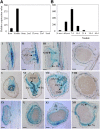
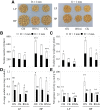
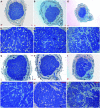
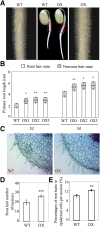
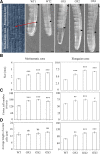
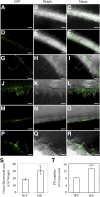
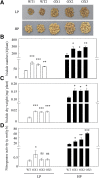
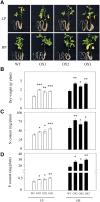

References
-
- Aleman L, Ortega JL, Martinez-Grimes M, Seger M, Holguin FO, Uribe DJ, Garcia-Ibilcieta D, Sengupta-Gopalan C (2010) Nodule-enhanced expression of a sucrose phosphate synthase gene member (MsSPSA) has a role in carbon and nitrogen metabolism in the nodules of alfalfa (Medicago sativa L.). Planta 231: 233–244 - PMC - PubMed
-
- Barraza A, Estrada-Navarrete G, Rodriguez-Alegria ME, Lopez-Munguia A, Merino E, Quinto C, Sanchez F (2013) Down-regulation of PvTRE1 enhances nodule biomass and bacteroid number in the common bean. New Phytol 197: 194–206 - PubMed
Publication types
MeSH terms
Substances
LinkOut - more resources
Full Text Sources
Other Literature Sources

